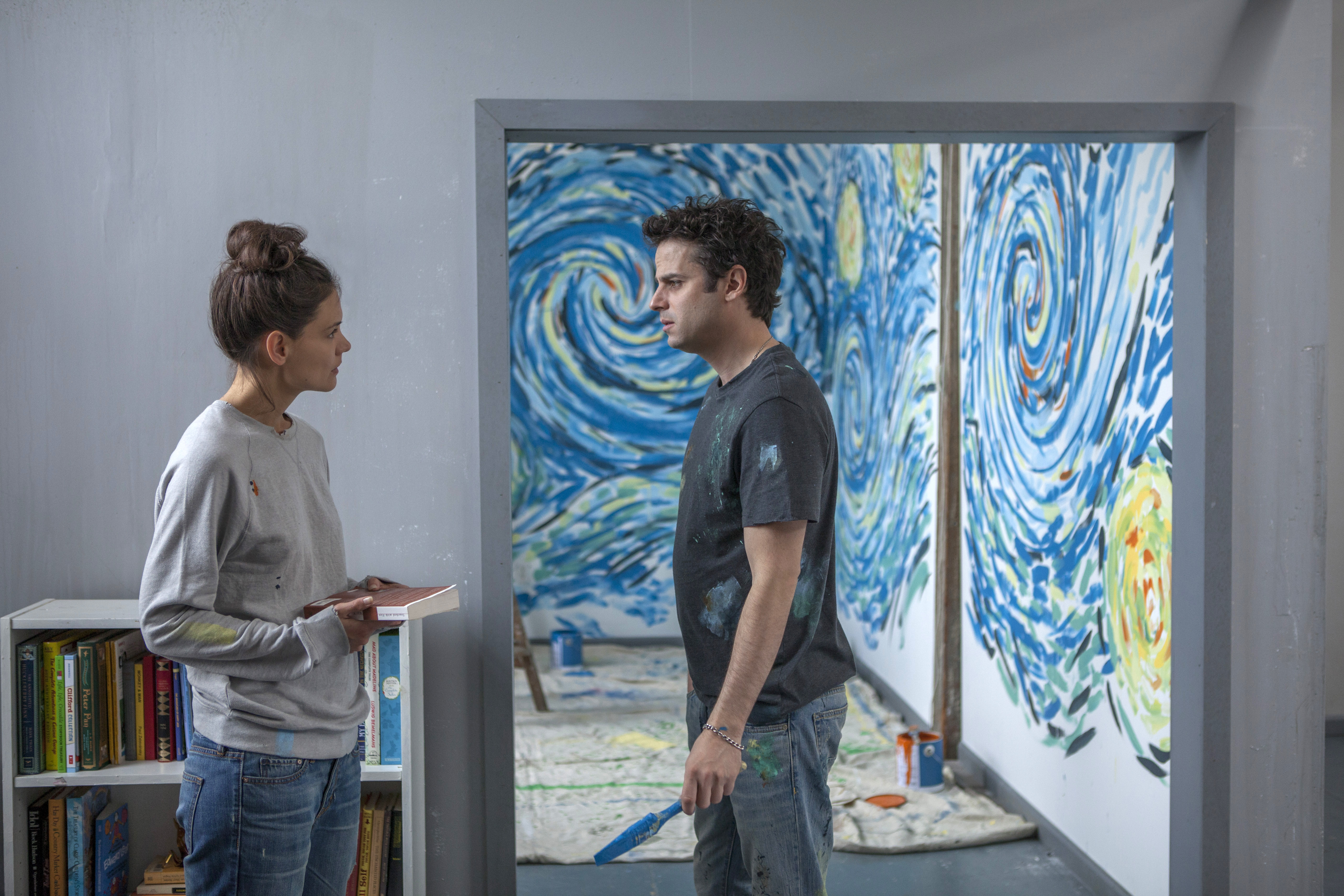Ask the Actor, Luke Kirby: How did you and Katie Holmes prepare to star in “Touched With Fire”?
Touched With Fire (2016) stars Katie Holmes and Luke Kirby as two bipolar poets, Carla and Marco, who meet in the hospital and fall in love. The couple push each other to new heights of creativity and joy but also to new extremes of mania, causing their families to fear that they will lead each other to self-destruction.
Portraying a character with mental illness is a difficult balance for an actor, who must authentically represent a real condition while creating a character with whom audiences can sympathize. Kirby told ScreenPrism that, in playing Marco, he began with what he related to and admired in the character. “One of the things that drew me into Marco was his aptitude for defiance,” he said. “I don’t know if I could relate to it, or there was something that I just admired about that kind of audacity. The more I thought about it, the more I started to see that so much of him is just in love with the ‘yes’ of life. He just wants to embrace that. He feels that will forge him on a path to some kind of ultimate. When you’re in that heightened state and that exuberance, it’s hard to argue with it. But if you’re somebody that cares for someone like that, and you see the reality in front of them, which is that there is this inevitable fall, you can really understand the concern. I just thought he was so impressive at how much he hates hearing ‘no.’ Just something about that righteousness was kind of endearing. It was youthful; it had a youthfulness to it. I could relate to it at times. When I was a kid, I loved playing make believe, and as soon as people wanted to stop, I was just galled that they weren’t wanting to keep following that make believe. I just couldn’t believe that they would want to stop because I found it to be such an exciting wave of imagination. To me it just seemed to wake up the world. So that was what was drawing me in.”
Meanwhile, in order to portray the bipolar condition accurately, he revisited Kay Redfield Jamison’s Touched with Fire: Manic-Depressive Illness and the Artistic Temperament, which features in the film and inspired its title. He also looked for sources “that described what it’s like physiologically, what it’s like to be told that there’s something wrong with you, what it’s like to be worried about how you are perceived, how it could impact your professional and personal life, all those things.”

Katie Holmes and Luke Kirby in Touched with Fire (2016)
Primarily, though, Kirby relied on the instructions and memories of his writer-director, Paul Dalio, who based the film on his own journey with bipolar. Dalio was open with the actors about his own life. “His real experience with this authenticated it,” Kirby said. “We spent a lot of time going for long walks around the city, just getting to know each other as two men, relating to what it is to be alive, moments of feeling isolated, moments of feeling rejected, moments of feeling entirely connected with the universe.” Kirby and Dalio’s working relationship benefited from their fast friendship and the fact that they could see themselves in each other, Kirby said. Meanwhile, Dalio was always able to guide his actors toward what was realistic. “He was such a great resource. Once we were into the doing of the film, he was there — obviously to do a lot — but one of the things for me was that he was able to be a barometer for where were at with the bipolar and discern if what we were doing had authenticity to it.”
Dalio told ScreenPrism he encouraged childlike movements during the characters’ manic periods, and “I tried to put them in that mindspace and flood them with information of all these associations that someone with bipolar would make.” Dalio said he gave his actors music composed by bipolar composers, poems by bipolar poets and paintings by bipolar painters, even bringing playlists and poetry to set that captured the energy he sought to capture.
For Kirby, one of the most helpful exercises was understanding how his body would be affected in any given moment. “Paul identified physical symptoms related to the disorder: shifts in temperature, shifts in breath, feelings in your body. It was very helpful just listening to Paul describe his life and seeing what the bipolar experience is like through his lens,” Kirby said in the film’s production notes. Dalio added, “Bipolar doesn’t randomly alter the senses… It enhances the senses – so much so that it can eventually become so magnified, it leads to distortion.”

Katie Holmes in Touched with Fire (2016)
Kirby also said he enjoyed working with Holmes in the film, describing her as curious, hard-working and determined. He praised her “ability to play and bring playfulness to a role. Anytime you get that off the bat, you’re in much better hands because that’s essentially what we have to do is get into a playful state. So she’s available for that, and that makes everyone’s job easier because you no longer have to conjure something, it’s just there. It’s a much more fluid approach.”
Kirby has now worked with both Holmes and her Dawson’s Creek (1998 - 2003) co-star Michelle Williams (in 2011’s Take This Waltz), but he joked that he finds it funny when members of the media press him to say he was a big fan of the teen favorite. “It’s just I didn’t watch the show,” he said. “I don’t look at Katie or Michelle in that wheelhouse. I’m aware of the work they’ve done since, and they’re both very compelling actors, and they’re both really lovely people that I feel so lucky to get to work with. It’s so great to meet people who just want to work.”
In the film’s production notes, Holmes said that when she first read the script, she was fascinated by the link between bipolar and the artistic impulse in the film. “They believe that being bipolar fuels their creativity,” she said. She saw her character’s task as “to figure out how she can get a handle on the dangerous side of this disease and still be creative.”
Holmes also said on The Today Show that she respected Dalio’s ability to allow viewers to make up their own minds about how to intepret the film as well as how to answer the question of medication. Holmes said the film presents “these two characters in a love story, which he’s saying it’s kind of its own mania to fall in love, but he puts the question out there for the audience to make that decision.”
Asked what he looks for in a potential role to play, Kirby told ScreenPrism, “It’s a heartbeat. If I feel like I can bring an element of that to it, then it might have value. At least I won’t feel like a total schmuck. I mean, it is a bit of an embarrassing profession, but if you feel like you bring something that is connected to something at your core on some level, then you can’t argue with it down the road because you chose it for the right reason—or it chose you, I don’t know how it works. It’s also just nice to work.”
Read our interview with Paul Dalio on how he visualized the bipolar experience on camera here.

